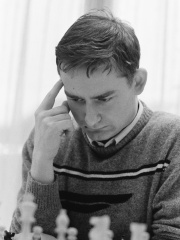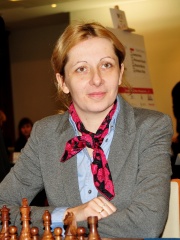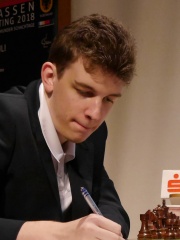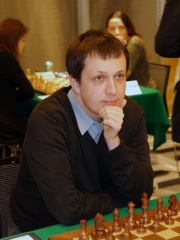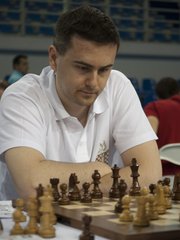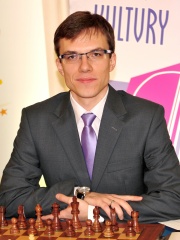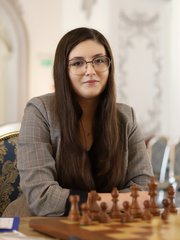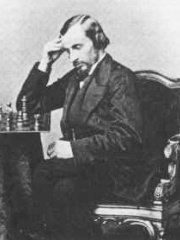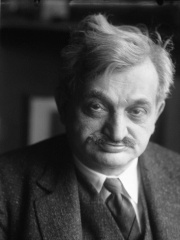
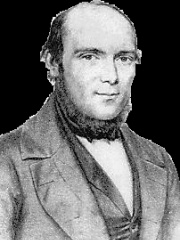
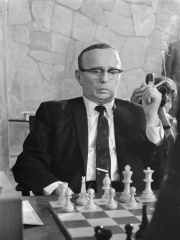
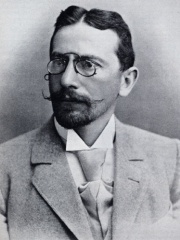
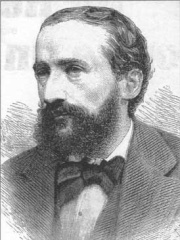
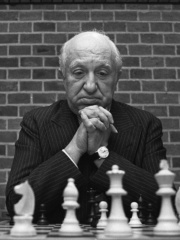
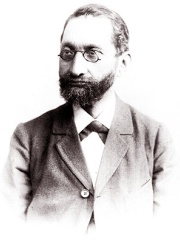
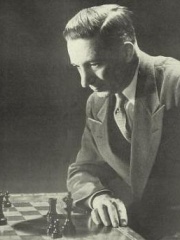
The Most Famous
CHESS PLAYERS from Poland
This page contains a list of the greatest Polish Chess Players. The pantheon dataset contains 461 Chess Players, 19 of which were born in Poland. This makes Poland the birth place of the 7th most number of Chess Players behind China, and India.
Top 10
The following people are considered by Pantheon to be the top 10 most legendary Polish Chess Players of all time. This list of famous Polish Chess Players is sorted by HPI (Historical Popularity Index), a metric that aggregates information on a biography's online popularity. Visit the rankings page to view the entire list of Polish Chess Players.

1. Emanuel Lasker (1868 - 1941)
With an HPI of 75.53, Emanuel Lasker is the most famous Polish Chess Player. His biography has been translated into 70 different languages on wikipedia.
Emanuel Lasker (German pronunciation: [eˈmaːnuɛl ˈlaskɐ] ; December 24, 1868 – January 11, 1941) was a German chess player, mathematician, and philosopher. He was the second World Chess Champion, holding the title for 27 years, from 1894 to 1921, the longest reign of any officially recognised World Chess Champion, winning 6 World Chess Championships. In his prime, Lasker was one of the most dominant champions. His contemporaries used to say that Lasker used a "psychological" approach to the game, and even that he sometimes deliberately played inferior moves to confuse opponents. Recent analysis, however, indicates that he was ahead of his time and used a more flexible approach than his contemporaries, which mystified many of them. Lasker knew contemporary analyses of openings well but disagreed with many of them. He published chess magazines and five chess books, but later players and commentators found it difficult to draw lessons from his methods. Lasker made contributions to the development of other games. He was a first-class contract bridge player and wrote about bridge, Go, and his own invention, Lasca. His books about games presented a problem that is still considered notable in the mathematical analysis of card games. Lasker was a research mathematician who was known for his contributions to commutative algebra, which included proving the primary decomposition of the ideals of polynomial rings. His philosophical works and a drama that he co-wrote, however, received little attention.

2. Adolf Anderssen (1818 - 1879)
With an HPI of 70.95, Adolf Anderssen is the 2nd most famous Polish Chess Player. His biography has been translated into 52 different languages.
Karl Ernst Adolf Anderssen (6 July 1818 – 13 March 1879) was a German chess master. He won the great international tournaments of 1851 and 1862, but lost matches to Paul Morphy in 1858, and to Wilhelm Steinitz in 1866. Accordingly, he is generally regarded as having been the world's leading chess player from 1851 to 1858, and leading active player from 1862 to 1866, although the title of World Chess Champion did not yet exist. Anderssen became the most successful tournament player in Europe, winning over half the events he entered, including the very strong Baden-Baden 1870 chess tournament. He achieved most of these successes when he was over the age of 50. Anderssen is famous today for his brilliant sacrificial attacking play, particularly in the Immortal Game (1851) and the Evergreen Game (1852). He was an important figure in the development of chess problems, driving forward the transition from the "Old School" of problem composition to the elegance and complexity of modern compositions. He was also one of the most likeable of chess masters and became an elder statesman of the game, to whom others turned for advice or arbitration.

3. Samuel Reshevsky (1911 - 1992)
With an HPI of 68.66, Samuel Reshevsky is the 3rd most famous Polish Chess Player. His biography has been translated into 38 different languages.
Samuel Herman Reshevsky (born Szmul Rzeszewski; November 26, 1911 – April 4, 1992) was a Polish chess prodigy and later a leading American chess grandmaster. He was a contender for the World Chess Championship from the mid 1930s to the late 1960s. He tied for third place in the 1948 World Chess Championship tournament, tied for second in the 1953 Candidates tournament, and was a Candidate as late as 1968. He was an eight-time winner of the US Chess Championship, tying him with Bobby Fischer for the all-time record. He was an accountant by profession, and also a chess writer.

4. Siegbert Tarrasch (1862 - 1934)
With an HPI of 68.58, Siegbert Tarrasch is the 4th most famous Polish Chess Player. His biography has been translated into 46 different languages.
Siegbert Tarrasch (German pronunciation: [ˈziːɡbɐt ˈtaraʃ]; 5 March 1862 – 17 February 1934) was a German chess player, considered to have been among the strongest players and most influential theoreticians of the late 19th and early 20th century.
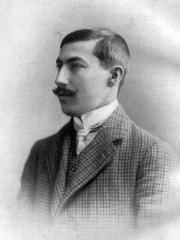
5. Akiba Rubinstein (1880 - 1961)
With an HPI of 67.18, Akiba Rubinstein is the 5th most famous Polish Chess Player. His biography has been translated into 35 different languages.
Akiba Kiwelowicz Rubinstein (1 December 1880 – 14 March 1961) was a Polish chess player. He is considered to have been one of the greatest players never to have become World Chess Champion. In his youth, he defeated top players José Raúl Capablanca and Carl Schlechter. He was scheduled to play a match with Emanuel Lasker for the World Chess Championship in 1914, but it was cancelled due to the outbreak of World War I. He was unable to re-create consistently the same form after the war, and his later life was plagued by mental illness. He was awarded the title of Grandmaster when FIDE introduced the title in 1950.

6. Johannes Zukertort (1842 - 1888)
With an HPI of 67.10, Johannes Zukertort is the 6th most famous Polish Chess Player. His biography has been translated into 36 different languages.
Johannes Hermann Zukertort (Polish: Jan Hermann Cukiertort; 7 September 1842 – 20 June 1888) was a Polish-born British-German chess master. He was one of the leading world players for most of the 1870s and 1880s, but lost to Wilhelm Steinitz in the World Chess Championship 1886, which is generally regarded as the first World Chess Championship match. He was also defeated by Steinitz in 1872 in an unofficial championship. Zukertort filled his relatively short life with a wide range of other achievements as a soldier, musician, linguist, journalist and political activist.

7. Miguel Najdorf (1910 - 1997)
With an HPI of 66.44, Miguel Najdorf is the 7th most famous Polish Chess Player. His biography has been translated into 36 different languages.
Miguel Najdorf ( NY-dorf; born Mojsze Mendel Najdorf; 15 April 1910 – 4 July 1997) was a Polish-Argentine chess grandmaster. Originally from Poland, he was in Argentina when World War II began in 1939, and he stayed and settled there. He was a leading world player in the 1940s and 1950s, and is also known for the Najdorf Variation, one of the most popular chess openings.

8. Szymon Winawer (1838 - 1919)
With an HPI of 60.98, Szymon Winawer is the 8th most famous Polish Chess Player. His biography has been translated into 22 different languages.
Szymon Abramowicz Winawer (March 6, 1838 – November 29, 1919) was a Polish chess player of world-class Master strength, who won the German Chess Championship in 1883.

9. Edward Lasker (1885 - 1981)
With an HPI of 59.44, Edward Lasker is the 9th most famous Polish Chess Player. His biography has been translated into 23 different languages.
Edward Lasker (born Eduard Lasker) (December 3, 1885 – March 25, 1981) was a German-American chess and Go player. He was awarded the title of International Master of chess by FIDE. Lasker was an engineer by profession, and an author of books on Go, chess and checkers. Born in Prussia, he emigrated to the United States in 1914. He was distantly related to World Chess Champion Emanuel Lasker with whom he is sometimes confused.
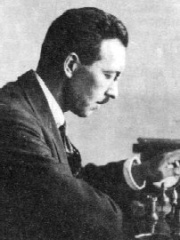
10. Grigory Levenfish (1889 - 1961)
With an HPI of 57.97, Grigory Levenfish is the 10th most famous Polish Chess Player. His biography has been translated into 19 different languages.
Grigory Yakovlevich Levenfish (Russian: Григо́рий Я́ковлевич Левенфи́ш; 19 March 1889 [O.S. 7 March] – 9 February 1961) was a Soviet chess player who scored his peak competitive results in the 1920s and 1930s. He was twice Soviet champion, in 1934 (jointly with Ilya Rabinovich) and 1937. In 1937 he drew a match against future world champion Mikhail Botvinnik. In 1950 Levenfish was among the first recipients of the title of Grandmaster, awarded by FIDE that year for the first time.
People
Pantheon has 19 people classified as Polish chess players born between 1818 and 2000. Of these 19, 8 (42.11%) of them are still alive today. The most famous living Polish chess players include Valery Salov, Monika Soćko, and Jan-Krzysztof Duda. The most famous deceased Polish chess players include Emanuel Lasker, Adolf Anderssen, and Samuel Reshevsky. As of April 2024, 2 new Polish chess players have been added to Pantheon including Bartłomiej Macieja, and Oliwia Kiołbasa.
Living Polish Chess Players
Go to all RankingsValery Salov
1964 - Present
HPI: 49.69
Monika Soćko
1978 - Present
HPI: 44.22
Jan-Krzysztof Duda
1998 - Present
HPI: 41.71
Radosław Wojtaszek
1987 - Present
HPI: 40.06
Bartosz Soćko
1978 - Present
HPI: 39.14
Bartłomiej Macieja
1977 - Present
HPI: 37.31
Mateusz Bartel
1985 - Present
HPI: 37.22
Oliwia Kiołbasa
2000 - Present
HPI: 31.13
Deceased Polish Chess Players
Go to all RankingsEmanuel Lasker
1868 - 1941
HPI: 75.53
Adolf Anderssen
1818 - 1879
HPI: 70.95
Samuel Reshevsky
1911 - 1992
HPI: 68.66
Siegbert Tarrasch
1862 - 1934
HPI: 68.58
Akiba Rubinstein
1880 - 1961
HPI: 67.18
Johannes Zukertort
1842 - 1888
HPI: 67.10
Miguel Najdorf
1910 - 1997
HPI: 66.44
Szymon Winawer
1838 - 1919
HPI: 60.98
Edward Lasker
1885 - 1981
HPI: 59.44
Grigory Levenfish
1889 - 1961
HPI: 57.97
Daniel Harrwitz
1823 - 1884
HPI: 56.41
Newly Added Polish Chess Players (2025)
Go to all RankingsOverlapping Lives
Which Chess Players were alive at the same time? This visualization shows the lifespans of the 11 most globally memorable Chess Players since 1700.

